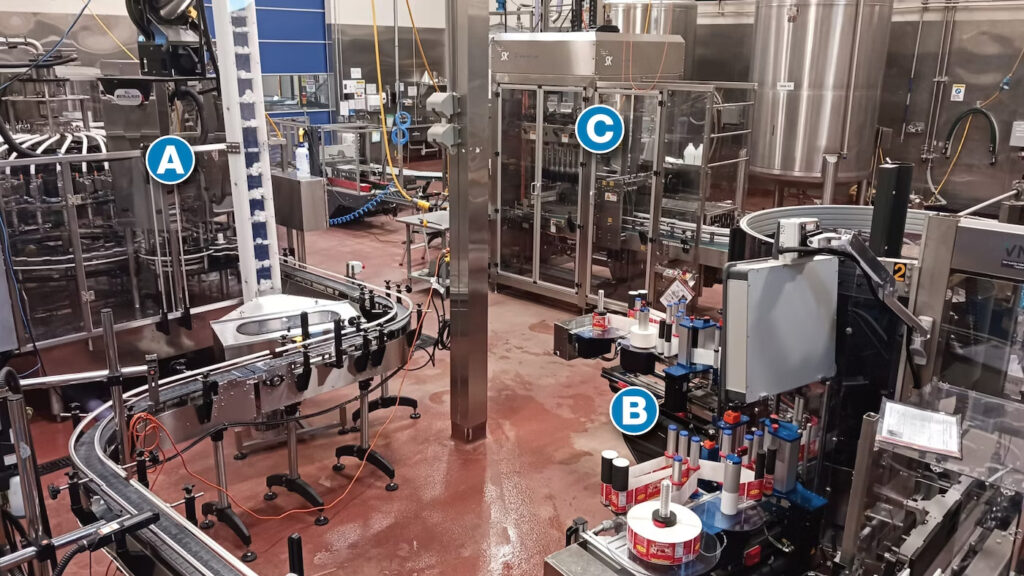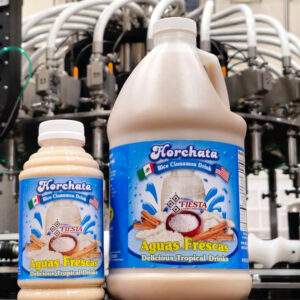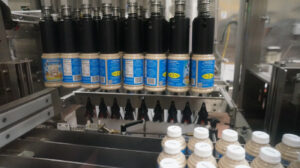New Filling Line Built From the Case Packer Back
With big retailers becoming customers and distribution reaching 17 states, Fiesta Pacific simply had to increase capacity. They started with the case packer and worked their way back.

Overhead view of Fiesta Pacific’s new line shows the filler/capper (A), the labeler (B), and the case packer (C).
In 1980 Manuel Marruenda started a home-based business in San Diego manufacturing and distributing Horchata, Jamaica, and Tamarindo, three beverages commonly found in Mexican restaurants. The firm now supplies more than 3,000 restaurants with Fiesta beverage dispensers and bag-in-box concentrates used in those dispensers, along with sales to retailers and grocery stores.
Also made now in the manufacturing facility occupied by Fiesta Pacific since 2006 are ethnic beverage concentrates sold in 16-oz PET and 64-oz HDPE containers. Growth of this business—which has been brisk now that large retailers like Walmart have put it in their stores—is overseen by Manuel’s son Manny Marruenda, now the president of the company. With distribution now reaching 16 states, it’s little wonder a new packaging line went into production this past January.

Both 16-oz PET and 64-oz HDPE bottles are filled on the line.
Considerable help in design and engineering, not to mention equipment evaluation, was provided by Russell Stone of RLS Mechanical Services, Ivoryton, Conn. A key provider of design and engineering consultation services, Stone says the line was built from the case packer back, that case packer being a 991 Unipack 2.0 from Standard-Knapp. “The case packer was really instrumental in making the line possible,” says Stone. “It has a very compact footprint considering the speeds at which it’s running. That would be 150 bottles per minute on the 64-ounce bottles and 200 per minute on the 16-ounce.”
Standard Knapp is well known for its high-speed, soft-catch drop packers used for partitioned or partitionless cases. But this machine at Fiesta Pacific is one of the firm’s very first gantry-style pick-and-place systems, where the picking device strokes perpendicular to the direction in which bottles are being conveyed in. With this approach, the machine footprint gets a lot smaller, says Mario Mazzotta, vice president of sales & marketing at Standard-Knapp.
“Our basic 9395 Versatron Case Packer is roughly 22.5 x 5.5 feet, or 125 square feet,” says Mazzotta. “The Unipack 2.0 running at Fiesta Pacific is 15 x 5 feet, or about 75 square feet. So it’s fair to say it represents about a 40% reduction in footprint.” Mazzotta also notes that it’s possible to add additional packing head assemblies to increase throughput if so desired.

Shown here are 16-oz PET bottles being carried toward the loading station of the case packer.
Notable on the Unipack 2.0 is its toolless changeover feature, including self-storing changeover racks that hold the picking tool not currently in use. To go to a new bottle size, the operator presses a button on the Rockwell HMI and the servo-driven pick head automatically goes to a docking rack where the picking tool currently in use can be stored. The operator then removes a couple of locking pins, disconnects some air hoses, and slides the tool into its docking rack. The pick head then moves to the docking rack of the tool needed for the new bottle size and the operator connects the air hoses and locking pins for that tool. With that the machine is ready for the new bottle size.
Moving back upstream
Once the case packer’s capacity was established, Stone and Marruenda moved their focus upstream machine by machine. At the very beginning of the line is a Model NEHCPCL-60 bottle unscrambler with integrated ionized air rinser from New England Machinery. An operator manually empties large bags of bottles into the unscrambler, which is also notable for its small footprint. Marruenda also likes how easy changeover from one bottle size to another is: “Altogether it takes about 15 to 20 minutes to change it over.”
When it came to picking a filler, one thing that was clear is that it was time to graduate from the in-line filling approach that Fiesta Pacific had always relied on and move to a rotary filler. “With the equipment we had we were lucky to fill 12 per minute on the 64-oz bottles,” says Marruenda. “Especially with the Horchata, which has a moderately viscous quality.”
Bottles reach the filler infeed in a single file and move through a feed screw that hands them off to a starwheel infeed. Bottles are filled by way of magnetic flow meters and then move by starwheel transfer into the chuck capper for application of the injection-molded polypropylene threaded closures.
New kind of case packer
After inspection, the bottles are fed in a single file toward the intermittent-motion Standard-Knapp case packer.
Cases are indexed into the loading station two at a time. For the 16-oz bottles, a lane divider spreads incoming bottles into three lanes so that the vacuum gripper heads on the gantry-mounted pick-and-place tool can pick 24 of the 16-oz bottles at a time and carry them to the loading station. There the pick-and-place tool descends through a grid and gently delivers bottles 12 per case. For the 64-oz size, 12 bottles are lifted with each cycle for a format of six bottles per case.
Filled cases move next to a Standard Knapp 199 Case Tape Sealer. The continuous-motion machine uses a pneumatic tucker for trailing flaps to ensure precise timing and consistent tape application. According to Standard Knapp’s Mazzotta, the taping system was kind of an afterthought.
“When Russ and Manny were at our facility to sign off on the case packer, I mentioned to them that we also make a case sealer that uses either glue or tape,” says Mazzotta. “We walked over to one that we had on the floor and ran it a few times and Manny pretty quickly asked me to quote him on the machine. He sent in a purchase order within a couple of weeks.”
The line has now been in commercial production since January. According to Stone, by the end of the third day it was running at about 70% efficiency, and within two months it was around 90%. Needless to say, it’s made it a whole lot easier to keep up with growing demand. Says Marruenda, “Moving to this new line was like going from a Volkswagon to a Ferrari.”
Copyright © 2024 Standard-Knapp, Inc.
Privacy | Accessibility
Transparency in Coverage
Sales: (860) 342-1100
Fax: (860) 342-1557